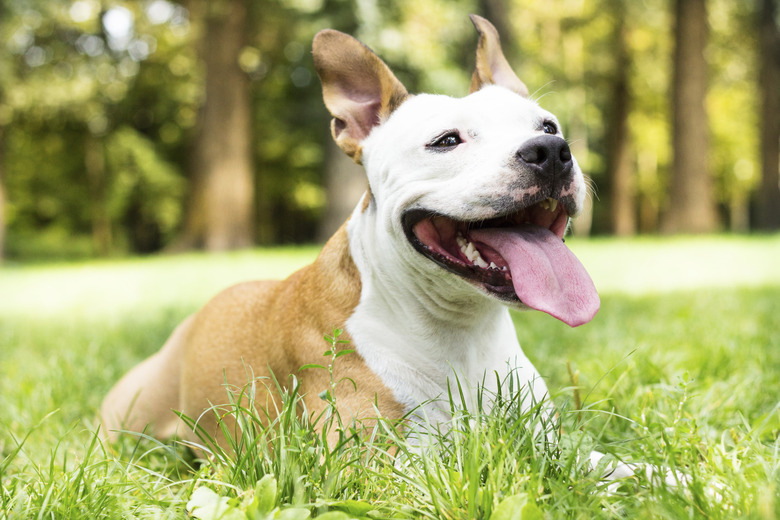Pit Bull Skin Problems
The American pit bull's short and somewhat stiff coat necessitates minimal grooming. However, sometimes pitbulls and skin conditions go hand in hand. The American pit bull and related breeds such as the American Staffordshire terrier are also prone to skin problems that can require some extra care. Learn how to prevent issues through a good diet, proper care, and effective cleaning.
Red, white, and blue
Red, white, and blue
Being a bully breed isn't the only thing that contributes to the potential for skin issues. Certain colors of the American pit bull come with increased susceptibility according to Finest Pitbulls Made Kennels (FPM). That cute cutis on a potential pet pup could be a consideration when it comes to itching, flaking, and other dermatological occurrences.
The beautiful blue-gray coat of blue-nose pitbulls is rare but sought-after coloring by fans of the breed. The recessive gene responsible for the striking coloration — along with poor breeding practices — also makes this type of dog one of the most prone to skin disorders among pitties according to Animal Corner.
White pitbulls are also especially prone to skin disorders. On a pitbull, skin bumps, rash, or frequent itching are common in both the white and blue colorations, according to FPM. Red pits are the least likely to have skin issues, according to the kennel, who recommends the red color for anyone concerned about buying a dog prone to skin issues.
Pitbull skin problems solutions
Pitbull skin problems solutions
Aside from genetics, there are plenty of dynamics that can cause your pit bull's skin problems. Check out these common issues that can leave your dog scratching or rubbing its skin.
Zinc deficiency
Zinc deficiency
If your pup looks like he's developing scales — even at a very young age — he might have zinc responsive dermatosis. The disorder arises when your pittie doesn't get enough zinc in his diet or can't digest it properly, according to Central Texas Veterinary Hospital. Other signs of this disorder can include redness, hairless or crusty areas, and oozing, especially around the mouth, chin, or eyes. You might also see lesions on your dog's ears, footpads, and nose.
Before adding zinc to your dog's diet, consult your veterinarian for proper dosage and method of delivery. Zinc in high quantities is toxic to dogs and can be fatal. When delivered in the right doses, it can be effective, but can also cause gastrointestinal issues, according to Tufts University.
Pitbull skin allergies and sensitivities
Pitbull skin allergies and sensitivities
If your dog is eating commercial kibble with corn, wheat, or soy, it might be making her itchy due to sensitivity to the ingredients. Scratching the ears or chewing on her feet are the most common symptoms, according to the American Kennel Club (AKC), but she could also suffer from diarrhea, vomiting, or excess gas.
True food allergies cause more severe symptoms and usually require immediate veterinary care. If your dog develops hives, facial swelling, or severe itchiness, contact your dog's doc immediately, as it could develop into life-threatening anaphylaxis.
Speak with your vet about switching your dog to a grain-free diet. Keep in mind that some dogs can be allergic to pork, chicken, beef, eggs, or other ingredients. Pitbulls Care recommends diets with the following three components:
- Limited ingredients — fewer ingredients mean less chance of something upsetting your dog's system
- Novel ingredients — Unique protein sources such as grass-fed bison or kangaroo can offer relief to dogs allergic to grain-raised farm animals. Kangaroo is also a good source of zinc to help with skin issues, according to Balanced Life Pet.
- Prescribed by your veterinarian — Although food from your vet might cost a little more per pound, it can save money in the long run over constantly changing dog food brands and trying to relieve the itch with topical salves.
Topical allergies and environmental irritants
Topical allergies and environmental irritants
Because pitbulls don't have a lush undercoat like many breeds, their skin naturally comes in contact with things in the environment. Grasses and pollen picked up on a walk could cause a dog's belly itch, or a change of laundry detergent used to wash bedding could trigger a rash.
Shampoo and other grooming products can also cause your pitbull's dry skin, making him itchy. Only bathe your pitbull when needed. Use tepid water to avoid irritating skin conditions advises MedVet, and use medicated shampoo and a conditioner to restore moisture to the skin. Alternatively, FPM recommends rubbing coconut oil into the skin.
Medical skin issues
Medical skin issues
If your dog is suffering from internal or external parasites, this could show up as itchy, red skin. Mange and mites are two common external parasites that can drive your dog to frequent scratching.
Neurological issues, fungal infections, yeast infections, and underlying diseases can also cause pitbull skin problems. Consult your vet if your dog shows signs of itching, red bumps, rash, flaking, or other skin conditions.
Always check with your veterinarian before changing your pet's diet, medication, or physical activity routines. This information is not a substitute for a vet's opinion.
References
- Central Texas Veterinary Hospital: The Truth About the Pitbull Terrier
- Finest Pitbulls Made: Blue Pitbull Skin Problems
- Animal Corner: Blue Nose Pitbull
- Tufts University: Copper-Associated Liver Disease in Dogs
- Pitbulls Care: The Best Dog Food for Pitbulls with Food Allergies
- American Kennel Club: Dog Allergies
- Balanced Life Pet: What is the Healthiest Meat to Feed Your Dog?
- MedVet: Bathing Recommendations For Dogs With Allergic Skin Disease
